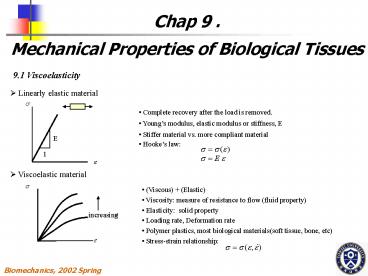9'1 Viscoelasticity - PowerPoint PPT Presentation
1 / 12
Title:
9'1 Viscoelasticity
Description:
Aging effect. Density. Strength and stiffness. 9.7.4 Bone fractures ... Bending fractures: 'butterfly' fragments. Fatigue fractures: repeated mechanical stress ... – PowerPoint PPT presentation
Number of Views:321
Avg rating:3.0/5.0
Title: 9'1 Viscoelasticity
1
Chap 9 . Mechanical Properties of Biological
Tissues
9.1 Viscoelasticity
- Linearly elastic material
- Complete recovery after the load is removed.
- Youngs modulus, elastic modulus or stiffness, E
- Stiffer material vs. more compliant material
- Hookes law
- Viscoelastic material
- (Viscous) (Elastic)
- Viscosity measure of resistance to flow (fluid
property) - Elasticity solid property
- Loading rate, Deformation rate
- Polymer plastics, most biological materials(soft
tissue, bone, etc) - Stress-strain relationship
2
9.2 Analogies Based on Springs and Dashpots
- Linear spring
- Elastic solid
k
E
x
E
k
1
1
Hookes law
3
9.2 Analogies Based on Springs and Dashpots
(continued)
- Dashpot
- Newtonian fluid (linearly viscous fluid)
Damping force is directly proportional to the
speed.
Shear stress is directly proportional to the
strain rate.
1
1
4
9.3 Empirical Models of Viscoelasticity
- Vicoelastic material
- A constant applied force (stress) produces a
constant deformation (strain) in a spring. - A constant applied force (stress) produces a
constant rate of deformation (strain rate) in a
dashpot. - The deformation in a spring is completely
recoverable. - The deformation in a dashpot is permanent.
- Dashpot Viscous fluid
- Spring Elastic solid
E
- Stress relaxation change of stress under a
const deformation - Creep change of deformation under a const
loading
5
9.4 Time-Dependent Material Response
- Creep change of deformation under a const
loading
- Stress relaxation change of stress under a
const deformation
- Oscillatory response oscillatory loading
6
9.5 Comparison of Elasticity and Viscoelasticity
- Elastic material
- Unique relationship
- Viscoelastic material
- time-dependent
- speed as well as magnitude of the stress
increasing
7
9.5 Comparison of Elasticity and Viscoelasticity
(continued)
- Elastic material
loading
unloading
- Viscoelastic material
U
R
Y
P
loading
unloading
Hysteresis loop for an elastic-plastic material
Hysteresis loop
8
9.6 Common Characteristics of Biological Tissues
- Biological Tissues
- Living tissues are very difficult to determine
material properties. - Composite materials
- Nonhomogeneous and anisotropic
- Collagen to withstand axial tension
- Elastin elastic
1
2
9
9.7 Biomechanics of Bone
- Primary structural element of the human body.
9.7.1 Composition of bone
- Composite material
- Cortical or compact bone
- Cancelleous, trabecular or spongy bone
- Periosteum
9.7.2 Mechanical properties of bone
- Nonhomogeneous because of various cells and
organic and inorganic substances - Anisotropic
- Can resist rapidly applied loads better than
slowly applied loads. (Stiffer and stronger at
higher strain rates) - Viscoelastic
10
9.7 Biomechanics of Bone (continued)
9.7.2 Mechanical properties of bone (continued)
- Fast loading vs. Slow loading
- Longitudinal loading vs. Transverse loading
Fast loading
Longitudinal loading
slow loading
Transverse loading
11
9.7 Biomechanics of Bone (continued)
9.7.3 Structural integrity of bone
- Wet vs. Dry
- Aging effect
- Density
- Strength and stiffness
Dry bone
Wet bone
9.7.4 Bone fractures
- Tensile fractures cancellous bones
- Compressive fractures vertebrae of the elderly,
oblique fracture pattern - Torsional fractures spiral oblique pattern
- Bending fractures butterfly fragments
- Fatigue fractures repeated mechanical stress
12
9.8 Biomechanics of Tendons and Ligaments
- Tendons connection between muscle and bone
- Ligaments join bones and provide stability to
the joints - Tendons and ligaments are passive.
- (Muscle are active to produce mechanical force.)
- Tendons stiffer, higher tensile strength
- Uniaxial tension test
loading
unloading
0
0
0.05
0.1
0.05
0.1
Strain rate dependent ?-? curve for tendon
Hysteresis loop of stretching and relaxing of the
tendon































